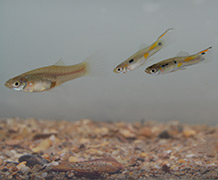articles

A female and two male guppies (Poecilia reticulata) from the Arima River, Trinidad. Photo by Darren P. Croft, University of Exeter UK
Female guppies become better swimmers to escape male sexual harassment
In the animal world, sexual reproduction can involve males attempting to entice or force females to mate with them, even if they are not initially interested.
This male behaviour is driven by conflicts of interest over reproduction and exerts selective pressures on both sexes.
A new study on guppies led by the universities of Glasgow and Exeter has given scientists insight into how this behaviour can lead to physiological changes, much like those in athletes who train to perform better.
Dr Shaun Killen, of the University of Glasgow, said: “Sexual coercion of females by males is widespread across sexually reproducing species.
“Typically, male reproductive success is limited by access to females, and males of many species will try to overcome this using a number of behaviours, such as chasing and even attacking females in an attempt to gain a mating.
“These types of behaviours are considered sexually harassing as males are attempting to coerce females into mating with them. Females can spend a lot of energy avoiding males in these situations and can even be injured.
“To reduce these costs, one possibility is that females may be able to change their own behaviour or physiology in ways that reduce the negative energetic consequences of harassment or allows them to more easily escape male coercion.”
Dr Killen and his colleagues tested this idea in a laboratory setting by exposing female Trinidadian guppies (Poecilia reticulata) for several months to varying levels of male harassment that they would normally encounter in the wild.
Dr Safi Darden of the University of Exeter explained: “In the wild, male guppies spend most of their time courting and coercing females in an attempt to mate with them. Most of this male attention is unwanted and females attempt to avoid males by rapidly swimming away from them during pursuits.”
After five months, females exposed to higher levels of harassment were able to swim much more efficiently, using less energy to swim at a given speed compared to those exposed to lower levels of harassment.
Dr Darden said: “It seems that prolonged increases in high-intensity swimming in females, caused by male harassment, leads to changes in the physiology or swimming mechanics of individual fish, which reduces the energy costs of swimming and could allow female guppies to reduce the burden of this coercive behaviour.”
Dr Killen added: “An important factor appears to be swimming technique, and female guppies that experienced lower levels of harassment spent more time swimming with their pectoral fins extended, an indicator of an inefficient swimming technique.
“This change is very similar to that seen in human athletes who train to become better at their sports.”
Co-author Professor Darren Croft of the University of Exeter added: “In the broader context our findings show that swimming efficiently is something that fish may have to learn and practice. As with learning to swim in humans, this takes time and energy, both of which are very costly for these fish. This can explain why it is only the fish that are exposed to higher levels of harassment from males which develop the refined swimming technique”.
The study was funded by the Natural Environment Research Council and the Leverhulme Trust.
Date: 24 August 2015
